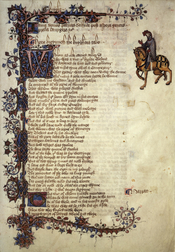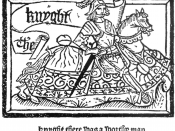The Canterbury Tales
The Canterbury Tales is a collection of stories set within a framing story
of a pilgrimage to Canterbury Cathedral, the shrine of Saint Thomas à Becket.
The poet joins a band of pilgrims, vividly described in the General Prologue, who
assemble at the Tabard Inn outside London for the journey to Canterbury.
Ranging in status from a Knight to a humble Plowman, they are a microcosm of
14th- century English society.
The Host proposes a storytelling contest to pass the time; each of the 30
or so pilgrims (the exact number is unclear) is to tell four tales on the round trip.
Chaucer completed less than a quarter of this plan. The work contains 22 verse
tales (two unfinished) and two long prose tales; a few are thought to be pieces
written earlier by Chaucer. The Canterbury Tales, composed of more than 18,000
lines of poetry, is made up of separate blocks of one or more tales with links
introducing and joining stories within a block.
The tales represent nearly every variety of medieval story at its best. The
special genius of Chaucer's work, however, lies in the dramatic interaction between
the tales and the framing story. After the Knight's courtly and philosophical
romance about noble love, the Miller interrupts with a deliciously bawdy story of
seduction aimed at the Reeve (an officer or steward of a manor); the Reeve takes
revenge with a tale about the seduction of a miller's wife and daughter. Thus, the
tales develop the personalities, quarrels, and diverse opinions of their tellers.
After the Knight's tale, the Miller, who was so drunk that he could barely
sit on his horse, began screaming,' I know a tale that can cap the Knight's tale
off!' 'But first, said the Miller, 'I admit that...
![[Portrait of Albert Nicholas and Rudi Blesh, Riverboat on the Hudson, N.Y., ca. July 1947] (LOC)](https://s.writework.com/uploads/5/51046/portrait-albert-nicholas-and-rudi-blesh-riverboat-hudson-n-thumb.jpg)

